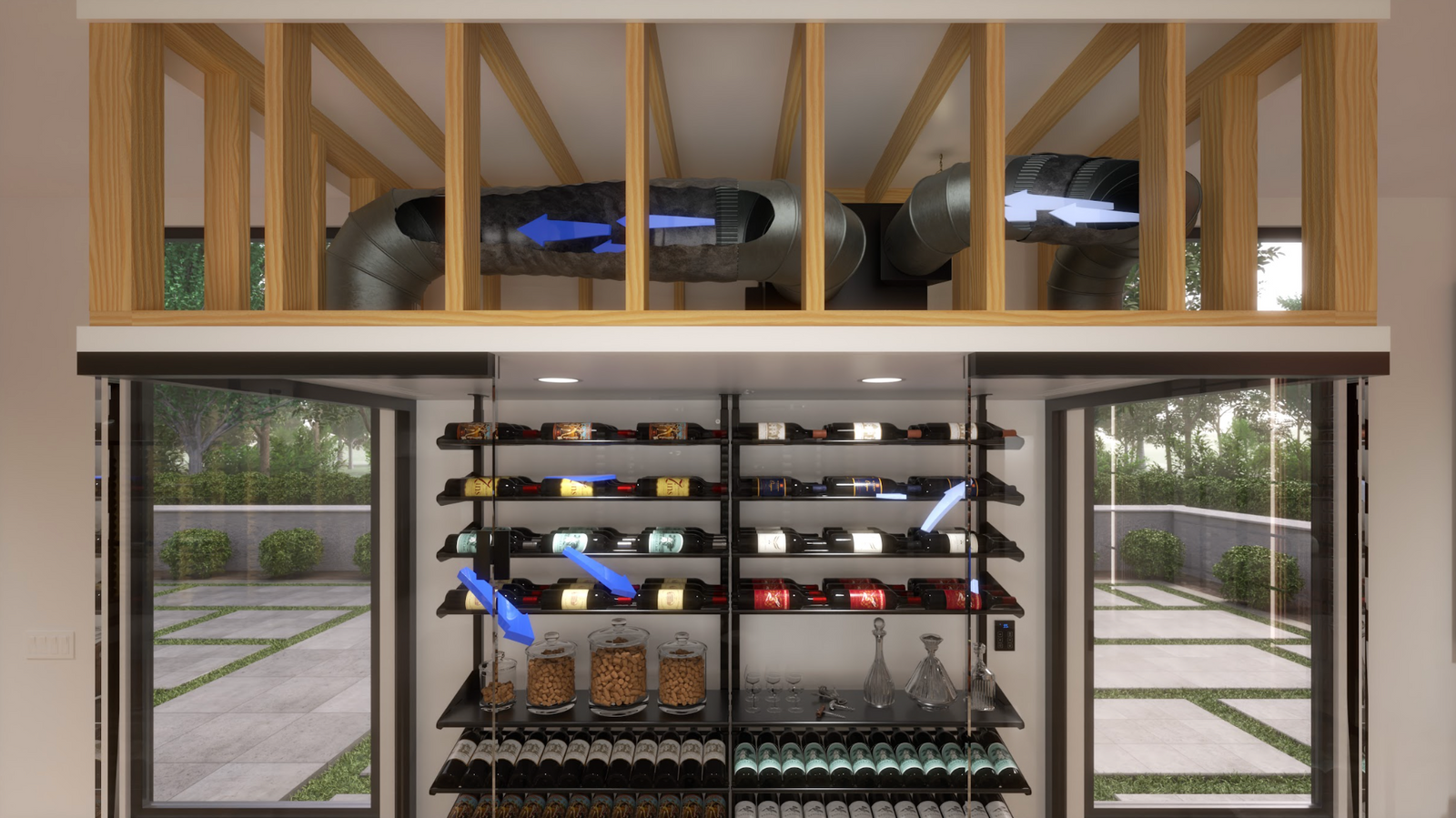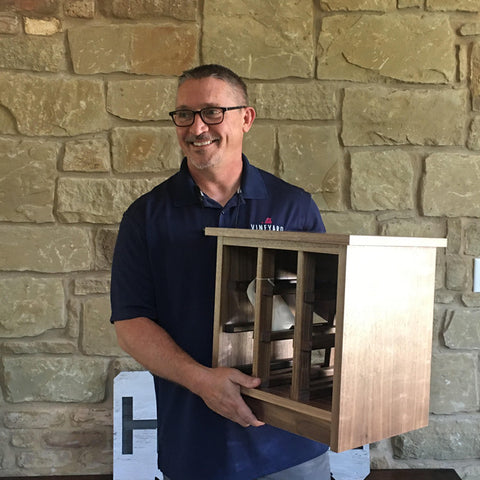Your wine collection deserves the perfect storage environment, starting with the right cooling system.
The two primary options—ductless and ducted cooling systems—offer distinct benefits depending on your cellar size, preferences, and installation needs.
Understanding the different wine cellar cooling units will help you choose the best system to preserve your wines for years.
Table of Contents
- Understanding Wine Cellar Cooling Systems
- The Importance of Proper Wine Storage
- Ductless Wine Cellar Cooling Unit: Overview
- Ducted Wine Cellar Cooling System: Overview
- Cost Comparison: Ductless vs. Ducted Options
- Selecting the Right Cooling System for Your Collection
- Ductless Cooling Unit Maintenance
- Ducted Units Maintenance
- Conclusion
Understanding Wine Cellar Cooling Systems
A wine cellar cooling system is crucial for wine storage. Here’s why they’re essential:
-
Precise Temperature Control
-
Ideal wine storage conditions range between 55°F and 58°F (13°C–14°C).
-
Standard HVAC units fluctuate excessively, risking spoilage.
-
-
Humidity Regulation
-
Wine cellar cooling units require 50%-70% humidity levels to prevent cork drying and mold, avoiding oxidation and contamination.
-
-
-
Self-contained units (single-piece systems)
-
Split systems (which can be either ducted or ductless with separate evaporator and condenser)
-
-
Energy Efficiency
-
Cooling units save energy over makeshift solutions.
-
Investing in the right unit prevents costly heat damage.
-
The Importance of Proper Wine Storage
1. Climate Stability
-
The ideal temperature range is 55°F–58°F (13°C–14°C).
-
Fluctuations can damage the wine.
2. Controlled Humidity
-
Too low = Corks dry out, allowing air in.
-
Too high = Mold growth, label damage.
3. Protection from Light and Vibration
-
UV exposure degrades wine.
-
Movement disrupts wine aging and flavor.
Ductless Wine Cellar Cooling Unit: Overview
Ductless wine cellar cooling systems, or ductless split systems, feature two main components:
-
an evaporator installed inside the wine room
-
a condensing unit in a remote location.
Ductless Systems Key Features
The split system provides several advantages for wine collectors:
-
Installation Flexibility: Can be installed in various configurations to accommodate different wine cellar designs
-
Noise Reduction: The condensing unit is located away from the wine room, creating a quiet atmosphere
-
Energy Efficient: Many models offer excellent energy performance
-
Temperature Precision: Maintains consistent climate throughout the wine storage room
Bestselling Ductless Wine Cooling Unit
Wine Guardian SS018 Ductless Split System Wine Cellar Cooling Unit
-
Both the evaporator and condenser enable flexible installation in tight spaces.
-
Various features to ensure quiet, energy-efficient operation.
-
Maintains temperature while protecting your collection for long-term aging.
WhisperKOOL Platinum Split 8000
-
Separately placed evaporator and condenser reduce wine cellar noise.
-
Maintains ideal serving temperature and humidity levels for long-term wine preservation.
-
The split system enables remote condenser placement for a sleek look.
Ducted Wine Cellar Cooling System: Overview
Ducted wine cellar cooling units use ductwork to circulate cool air.
They are typically installed in a mechanical room.
Vents circulate cool air while returning warm air to different sections of the wine cellar.
Why Choose Ducted Systems
Ducted units are particularly beneficial in specific scenarios:
-
Larger wine cellars require even cooling throughout the space
-
Aesthetic-first installations (hidden cooling components).
-
Wine Guardian systems can integrate with existing HVAC infrastructure
Bestselling Ducted Wine Cooling Unit
WhisperKOOL Platinum Split Twin Ducted
-
One unit with dual evaporators for even climate across large storage areas.
-
Efficient, quiet operation.
-
Specifically designed for wine collectors needing a high-capacity cooling solution.
Wine Guardian D088 Ducted Wine Cellar Cooling Unit
-
One unit integrates seamlessly for a sleek, hidden look.
-
Wine Guardian's evaporator and condenser ensure high efficiency and quiet operation.
-
Wine Guardian’s ducted technology preserves your collection’s aging potential.
Cost Comparison: Ductless vs. Ducted Options
Costs for wine cellar cooling units vary greatly between ductless and ducted, influenced by several factors.
Initial Purchase Price
Self-contained systems can be cost-effective but vary in price based on features and capacity.
Installation Expenses
Ducted wine cellar cooling generally requires dedicated equipment, though some systems can work alongside existing HVAC.
A licensed HVAC professional installation is needed, adding to the overall cost.
Ductless systems are cheaper initially, but ducted systems are more energy efficient in larger wine cellars, offering long-term savings.
Long-Term Operating Costs
Energy efficiency varies by system and insulation, potentially offsetting initial costs with long-term savings.
Installation Considerations
Ductless Split Installation
-
Mounting the evaporator unit inside the wine cellar
-
Connecting the two components with refrigerant lines
-
Placing the condensing unit in a remote area
-
Connecting the two components with refrigerant lines
-
Ensuring proper drainage and electrical connections in the storage space
Ducted Unit Installation
-
A mechanical wine room or nearby cooling unit.
-
Installation of ductwork to and from the wine cellar
-
Ducted systems need outside venting for heat dissipation.
Professional Installation
-
Licensed HVAC installation is often required for a warranty.
-
Improper installation is the leading cause of wine cooling system failures
-
Manufacturers recommend certified installers for optimal performance.
These systems often require venting outside during planning.
Pros and Cons Analysis
Advantages of Ductless Wine Cellar Cooling System
-
Flexibility: Works well in spaces with storage constraints
-
Aesthetics: Minimal visible components inside the wine cellar
-
Independent Operation: Works separately from HVAC.
Advantages of Ducted Wine Cellar Cooling Unit
-
Consistent Cooling: Even distribution in larger spaces.
-
Hidden Components: All machinery remains out of sight (require space for ductwork)
-
Integration: Compatible with existing HVAC
-
Scalability: More easily adapted for larger wine collections
Limitations to Consider
Both systems have their unique features and potential drawbacks:
-
Ductless systems need space for the condensing unit.
-
Ducted units require costly installation.
-
Self-contained systems may increase noise in wine cellars because the cooling system, including the compressor, is inside, unlike split systems that have remote components.
-
Cooling unit installation complexity varies significantly between options
Selecting the Right Cooling System for Your Collection
Assessing Your Space
When choosing between ductless and ducted wine cooling units, consider:
-
Available space for installation
-
Proximity to areas where noise might be an issue
-
Existing HVAC infrastructure
-
Size of your wine storage room
Considering Your Collection Size
-
Some wine cooling units may adequately serve smaller collections
-
Larger collections need ducted or powerful ductless split systems.
BTU Sizing Considerations
-
Proper BTU sizing is vital for performance.
-
Undersized cooling units cannot maintain optimal conditions in larger spaces
-
Oversized cooling system may cycle too much, impacting humidity and efficiency.
Maintenance Requirements
Ductless Cooling Unit Maintenance
-
Clean or replace cooling system filters.
-
Checking drain lines for proper operation
-
Ensuring evaporator coils remain clean
-
Inspect refrigerant levels regularly for optimal performance.
Ducted Units Maintenance
-
Regular inspection of ductwork for leaks or damage
-
Filter replacement on a scheduled basis
-
Monitoring of humidity systems in the cooling unit
-
Regularly service cooling components and inspect the ductwork.
Making Your Decision
Consider these factors when making your decision:
-
Available space
-
Noise sensitivity
-
Budget constraints
-
Integration with existing cooling unit
Conclusion
Ductless and ducted wine cooling units maintain optimal storage conditions.
Ductless systems are flexible and quiet, while ducted units provide even cooling in larger wine areas.
Quality equipment is essential for preserving your wine collection.
Which model do you think is for your wine storage?






